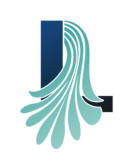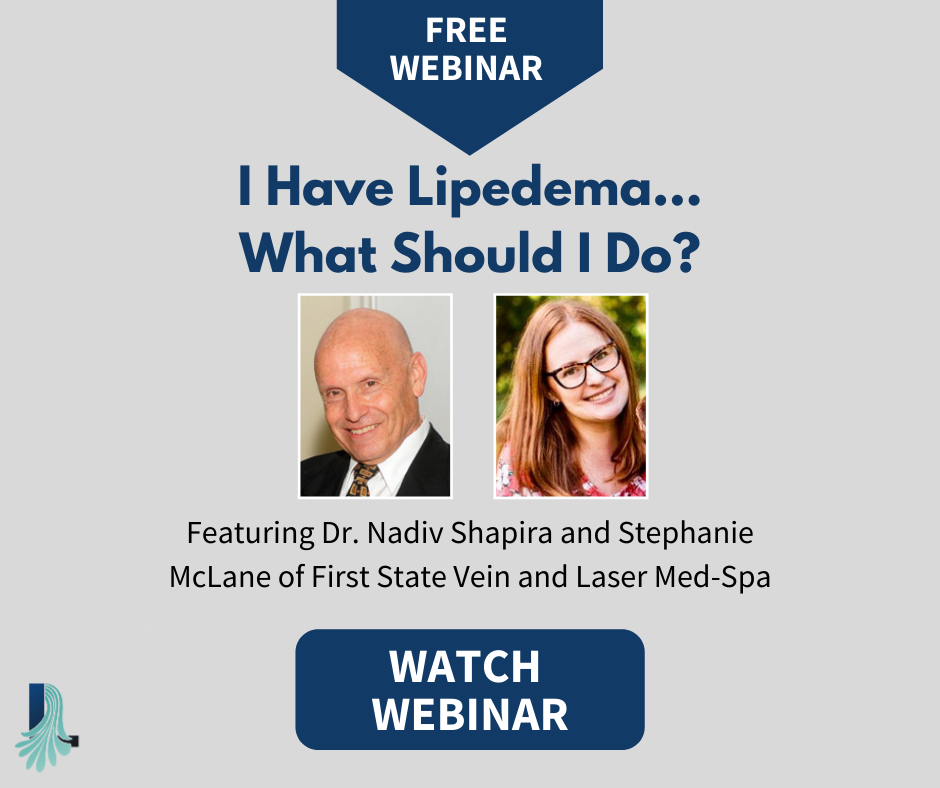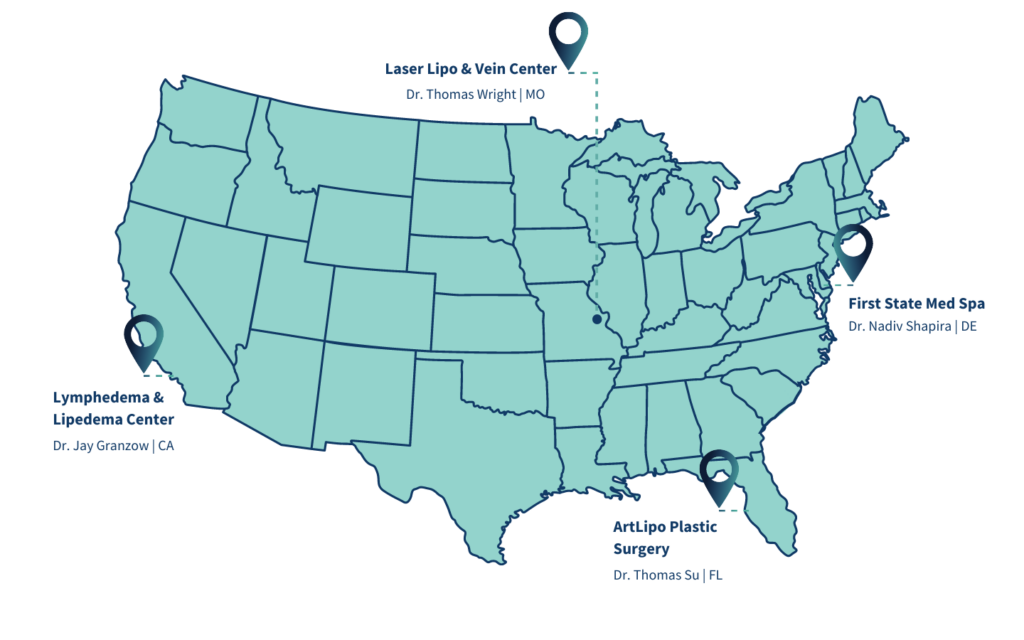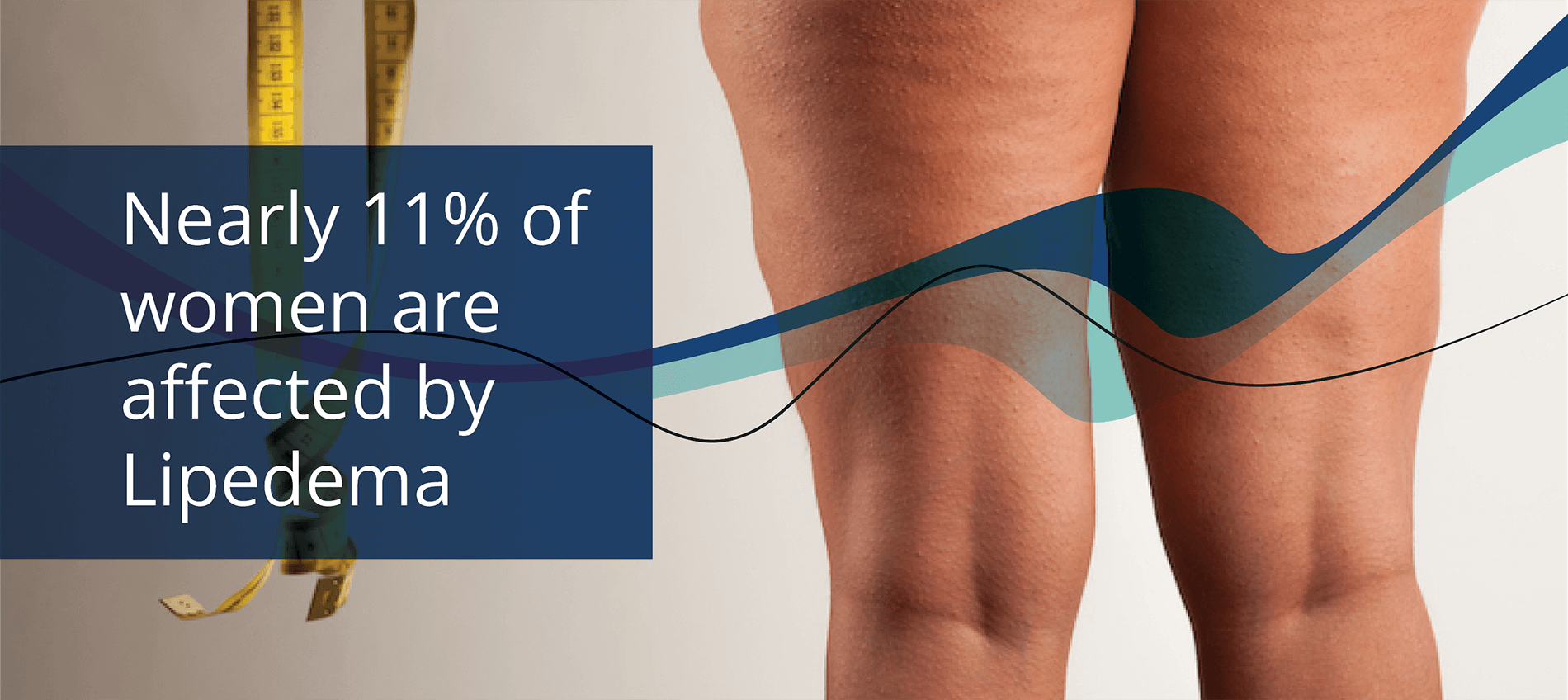
WHAT IS LIPEDEMA?
of the lipedema affected extremities and does not relieve the pain caused by lipedema. The best option to reduce the size of the extremity and improve pain symptoms caused by lipedema is by fat removal through liposuction.
While it is still not known what causes lipedema, there has been an increasing awareness about lipedema as a disease in recent years. Lipedema affects mainly women. It disfigures, causes pain, depression and other physical and psychological problems.
STAGES OF LIPEDEMA
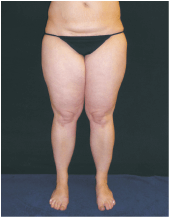 Patients with stage 1 develop a visibly bottom heavy, pear-shaped body with disproportionate distribution of fat on the legs in comparison to the upper body. Legs have a “column” appearance, with ankle “cuffing” when the lipedema is moderate to severe. The skin is smooth and even but when pinched, it develops an orange peel texture. The underlying subcutaneous tissues, particularly the inner thighs and knees feel thickened and soft like a polystyrene ball.
Patients with stage 1 develop a visibly bottom heavy, pear-shaped body with disproportionate distribution of fat on the legs in comparison to the upper body. Legs have a “column” appearance, with ankle “cuffing” when the lipedema is moderate to severe. The skin is smooth and even but when pinched, it develops an orange peel texture. The underlying subcutaneous tissues, particularly the inner thighs and knees feel thickened and soft like a polystyrene ball.
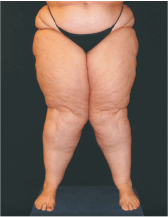 In stage 2, there is a pronounced pear-shaped body with disproportionately large, columnar appearing legs. The skin has a “mattress” appearance with a nodular surface, large dimples and nodes the size of walnuts to apples.
In stage 2, there is a pronounced pear-shaped body with disproportionately large, columnar appearing legs. The skin has a “mattress” appearance with a nodular surface, large dimples and nodes the size of walnuts to apples.
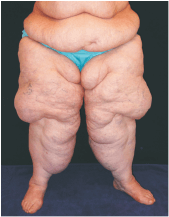 In Stage 3, the subcutaneous tissue is very thickened and hardened. There are large, deforming fat folds on the insides of the thighs and the knees, which can result in painful chafing and irritation of the area. In some cases, fat bulges hang over the ankles(“cuffing”) and constant high biomechanical stress on the joints result in a knock-kneed posture.
In Stage 3, the subcutaneous tissue is very thickened and hardened. There are large, deforming fat folds on the insides of the thighs and the knees, which can result in painful chafing and irritation of the area. In some cases, fat bulges hang over the ankles(“cuffing”) and constant high biomechanical stress on the joints result in a knock-kneed posture.
Due to the permanently high load and burden, the lymphatic vessels ‘fatigue’ over years and their transport capacity declines. The lymphatic fluid can no longer be drained off adequately and protein-rich edema develops. The protein deposits lead to hardening of the tissue, called fibrosis, and pathological changes to the lymphatic vessels (lymphangiosclerosis). Over time, Stage 3 can develop into secondary lymphedema and then lipo-lymphedema. In lipo-lymphedema there is swelling of the foot and a positive Stemmer’s sign.Some characterize lipolymphedema as stage IV of lipedema.
WHAT CAUSES LIPEDEMA?
YOU ARE NOT ALONE
WHAT ARE YOUR OPTIONS?
The first option to treat lipedema symptoms should be conservative such as Manual Lymphatic Drainage (MLD) and Complete Decongestive Therapy (CDT).
MLD is a massage that stimulates the movement of lymphatic fluid in the tissues and lymphatic vessels. CDT is a combination of MLD, bandaging exercises and skin care.
Following a Keto Diet can also help to reduce lymphedema symptoms.
For more information on conservative treatment options please check out these additional resources:
Liposuction is the only way to reduce the size of the legs or arms affected by lipedema. It can also help to reduce pain symptoms. There are different methods to aspirate the fat from the affected areas. The most important factor to consider when choosing a method one that will preserve the lymphatic vessels. Liposuction methods that are too aggressive can damage lymphatic vessels,
Tumescence method
Tumescence is the conventional method most commonly used to “swell” up the fat before it is removed by liposuction. This method utilizes tumescent fluid to infiltrate into targeted areas of fat. Tumescent fluid may contain a mixture of local anesthetic and epinephrine to control bleeding and bruising. In addition to controlling pain and bleeding, the tumescent fluid injected into the fat causes the fat to “swell” which makes the removal of fat through liposuction easier.
There are many different kinds of power-assisted methods used to remove unwanted fat from targeted areas of the body. These are vibrational, ultrasound or laser assisted liposuction. While these methods can use the same tumescent method, the most important difference is whether the liposuction method damages lymphatic vessels because it is too aggressive and indiscriminately suctions out fat.
Water-Jet Assisted Liposuction (WAL) is the only method that gently removes fat while protecting lymphatic vessels and surrounding tissues. Better than conventional methods of liposuction, WAL utilizes a fine, fan-shaped water jet to tenderly remove the fatty tissue with less effort and fewer side effects.
The WAL method minimizes the risk of bruising and injury to the nerves directly under the skin. Like tree roots, it is important for the tissue strands under the skin to remain widely intact for skin tightening.
In addition, the negative side effects of residual tumescent fluid in the fat are diminished because spraying and aspiration of the fat cells are done in tandem. This method also gives the physician direct control over the patient’s individual body contours during infiltration for better results.
The advantages of WAL are:
- Protects the surrounding tissue and lymphatic vessels
- Minimizes the risks of intervention, e.g. through less local anesthetic
- Lower pain rate: less blood loss, hematomas and swelling
- No general anesthesia and associated risks. Use of the WAL can be performed under local anesthesia.
- Minimal intraoperative swelling: surgery with almost unchanged body contours, low revision rate
- Reduced operation time by eliminating the waiting time for tumescent pre-infiltration as well as possible simultaneous rinsing and aspiration
- Easy cannula movement – more comfortable for the patient.
- Shorter and easier recovery.
The differences to note:
In contrast to conventional liposuction procedures, water-jet assisted liposuction (WAL) removes fat with the fan-shaped, fine water jet with significantly less effort and fewer side effects. The surrounding connective tissue, lymphatic vessels, nerves and blood vessels remain almost intact.
Unlike the WAL method, conventional tumescent methods use large amounts of tumescent fluid which can blur the body contours and result in contour irregularities and need for a revision. The WAL offers many advantages over the conventional tumescent method. The fan shaped spray and simultaneous aspiration of tumescent fluid and fat cells eliminates the need for pre-infiltration of fat. The advantage of this is less tumescent fluid is used to infiltrate the fat.
Contact us to learn more about these methods and to find an expert in your area, [email protected].
Lipedema affects millions of people, mostly women, and if left untreated, can have a devastating effect on quality of life. If you’ve been diagnosed with Lipedema, Lipoedema or Lymphadema, join us for an expert led webinar on the options available to you and how to find an a specialist near you. Dr. Nadiv Shapira of First Lipedema of Delaware, will outline the next steps to consider after being diagnosed. He will be joined by Stephanie McLane, Program Coordinator and Patient Advocate, who knows first-hand the struggles that come with Lipedema, after suffering from it for more than a decade. She will be sharing her extensive knowledge dealing with this disorder and treatments.
What is the difference between Lymphedema and Lipedema? What are the signs to observe? Join us to explore these answers and more to understand the effect these conditions can have from Dr. Jay Granzow, an internationally respected expert in Lymphedema and Lipedema surgery. Dr. Granzow will also explore the treatment methods available and share real patient experiences.
Join this webinar to learn from Dr. Nadiv Shapira and Stephanie McLane, of First State Lipedema of Delaware, the obstacles surrounding Lipedema to help you better understand the why and how when it comes to diagnosing and treating. In addition to sharing their knowledge and experience, they will also discuss dietary and therapeutic practices to consider adopting for optimal results.
